This month, Rand Bellavia takes a look at his growing longbox, and reflects on comics released in in November 1979, 1984, 1989, 1994, 1999, 2004, 2009, and 2014! Rand Bellavia is back to share his fond memories of decades of comic collecting and reading in this month’s Random Access Memory.
November 1979
Captain America 242
 Marvel got away with a lot of very weird comics in the late seventies. As strange as this comic is, it was a pretty typical Marvel comic from my childhood.
Marvel got away with a lot of very weird comics in the late seventies. As strange as this comic is, it was a pretty typical Marvel comic from my childhood.
Here we have Peggy Carter turning the Falcon to dust and then committing the impressive act of suicide by deflection.
 Peggy turns to dust — but not before delivering a final line of dialogue — and Cap demonstrates hitherto unbeknownst forensic abilities.
Peggy turns to dust — but not before delivering a final line of dialogue — and Cap demonstrates hitherto unbeknownst forensic abilities.
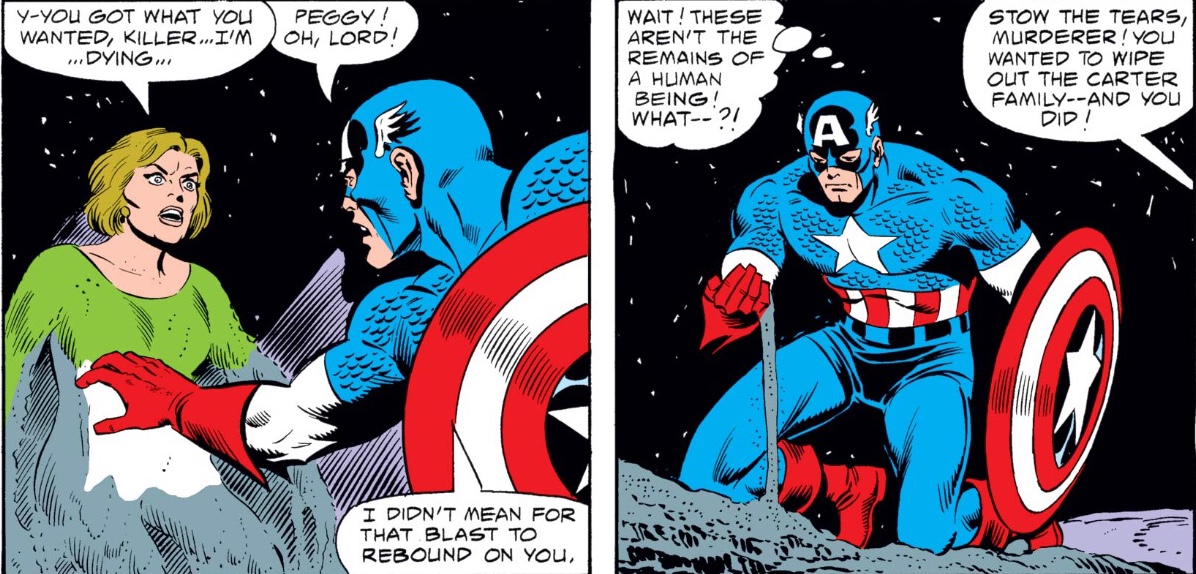 Inexplicably turning to dust was one of my childhood fears.
Inexplicably turning to dust was one of my childhood fears.
Nick Fury shows up, but it’s not really Nick Fury. And by the time the Avengers goose-step into frame, it’s clear that Cap is as high as writer Steven Grant.
 Predictably, it was the (disturbingly phallic) Red Skull all along!
Predictably, it was the (disturbingly phallic) Red Skull all along!
 So many shocks and twists! It’s like comic book improv.
So many shocks and twists! It’s like comic book improv.
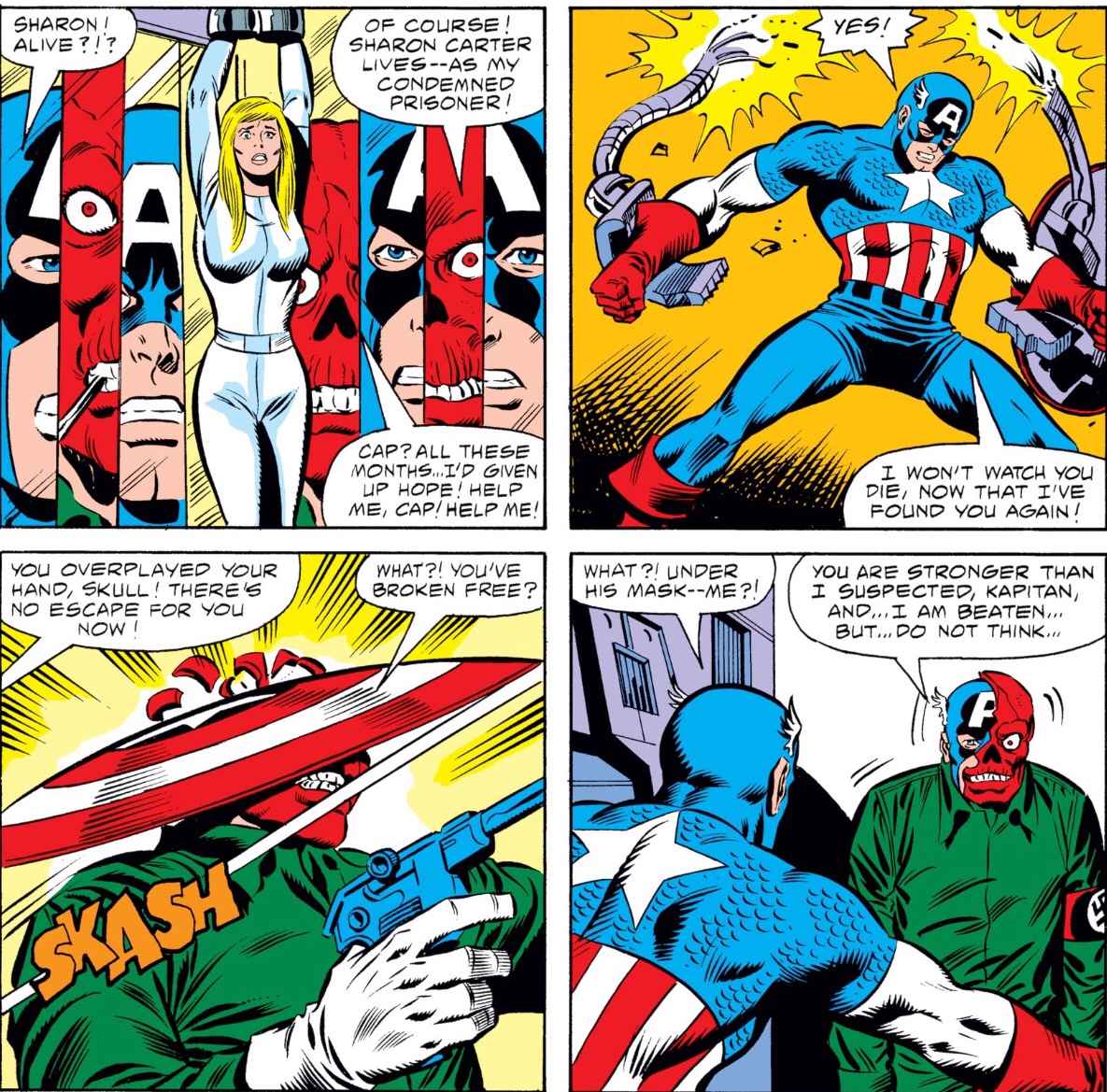 Turns out the Red Skull wasn’t real, either. And, in a classic case of “a bit too on the nose,” we learn that Cap is being manipulated by the Manipulator.
Turns out the Red Skull wasn’t real, either. And, in a classic case of “a bit too on the nose,” we learn that Cap is being manipulated by the Manipulator.
 Why the Manipulator is Janus-faced is never addressed.
Why the Manipulator is Janus-faced is never addressed.
Not enough unnecessary twists for you? Well, as Alan Moore thankfully never asked, “Who Manipulates the Manipulator?”

Comics I Read From November 1979
- Amazing Spider-Man 201
- Avengers 192
- Uncanny X-Men 130
November 1984
Saga of the Swamp Thing 33
 Growing up reading comics in the 70s it was pretty common to get an issue that was essentially a reprint with a new (and hastily thrown-together) framing sequence. So I was prepared (but no less disappointed) to discover that Swamp Thing 33 was really just a reprint of House of Secrets 92. The reprint was a stand alone story by Len Wein and Bernie Wrightson about a scientist who dies in an explosion and later rises from the swamp to exact his revenge.
Growing up reading comics in the 70s it was pretty common to get an issue that was essentially a reprint with a new (and hastily thrown-together) framing sequence. So I was prepared (but no less disappointed) to discover that Swamp Thing 33 was really just a reprint of House of Secrets 92. The reprint was a stand alone story by Len Wein and Bernie Wrightson about a scientist who dies in an explosion and later rises from the swamp to exact his revenge.
Of course this story sounds familiar, but it takes place in the early 1900s, and the scientist is named Alex Olsen. The success of the short story led Wein and Wrightson to retool the plot and retell it with the Alec Holland we all know and love in Swamp Thing issue one. (Weird thing: both Alex and Alec are married to women named Linda.)
So why did they reprint this story in Swamp Thing 33? The Dreaded Deadline Doom? That what I thought when I first read the issue, but this is Alan Moore, and I really should have known better. The framing sequence is a dream of Abby’s, where she encounters Cain and Abel, the “crypt-keeper” figures from the Houses of (respectively) Secrets and Mystery.
 Abby chooses a secret, and Abel presents her with the story from House of Secrets 92. She (and we) aren’t sure what to make of it, so Abel explains:
Abby chooses a secret, and Abel presents her with the story from House of Secrets 92. She (and we) aren’t sure what to make of it, so Abel explains:
 So, not only does Alan Moore successfully fold Wein and Wrightson’s Swamp Thing dry-run story into official Swamp Thing continuity, and not only does this set up years of great Swamp Thing stories (from both Moore and future Swamp Thing writers) but he also manages to make Cain and Abel actual characters in the proper DC Universe (readers of Neil Gaiman’s Sandman certainly appreciate that) while also canonically establishing a distinction between the stories published in House of Secrets and House of Mystery. Pretty impressive for a reprint/fill-in issue!
So, not only does Alan Moore successfully fold Wein and Wrightson’s Swamp Thing dry-run story into official Swamp Thing continuity, and not only does this set up years of great Swamp Thing stories (from both Moore and future Swamp Thing writers) but he also manages to make Cain and Abel actual characters in the proper DC Universe (readers of Neil Gaiman’s Sandman certainly appreciate that) while also canonically establishing a distinction between the stories published in House of Secrets and House of Mystery. Pretty impressive for a reprint/fill-in issue!
At any rate, the kind-hearted Abel tries to let Abby escape with full knowledge of her secret, but Cain has something to say about that.
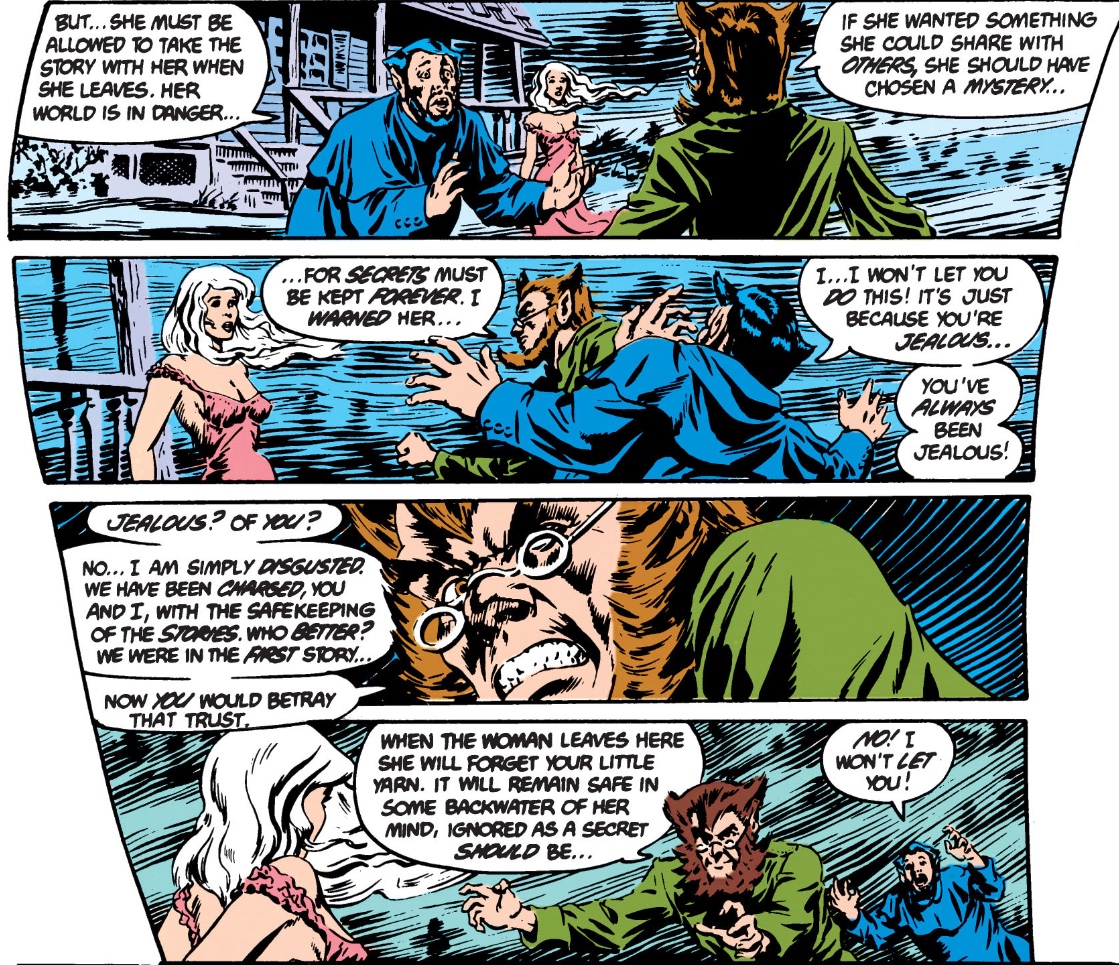 Poor Abel never learns…
Poor Abel never learns…
 Abby wakes up with the fleeting feeling that she dreamed something very important, but as she’s frantically trying to write it all down, she’s interrupted by “a person from Porlock” and is left with 50-odd compelling but incomplete lines about Kubla Khan.
Abby wakes up with the fleeting feeling that she dreamed something very important, but as she’s frantically trying to write it all down, she’s interrupted by “a person from Porlock” and is left with 50-odd compelling but incomplete lines about Kubla Khan.
Comics I Read From November 1984
- Aardvark-Vanaheim in 3D
- Alien Worlds 8
- Avengers 252
- Cerebus 68
- Conan the King 27
- Defenders 140
- Dreadstar 16
- Fantastic Four 275
- Kitty Pryde and Wolverine 4
- Kull 8
- Mage 5
- Marvel Super-Hero Secret Wars 11
- Marvel Team-Up 150
- Peter Parker the Spectacular Spider-Man 99
- Somerset Holmes 5
- Thor 352
- Twisted Tales 9
- Uncanny X-Men 190
- Vigilante 14
November 1989
Animal Man 19

Nearly two years into his Animal Man run, Grant Morrison finally lets the reader — and Animal Man — in on the meta-textual nature of his narrative. Buddy had been promised three secrets, and the third one is a doozy.

And we get one of the most famous splash pages of the 1990s.

Following this revelation, things turn decidedly theological.

This is one of those observations that seems as obvious as it does original. We create out of need, so why do we assume our creator creates out of benevolence?
Later, Buddy explores the nature of his newly discovered reality, and we get some pretty great visual gags.
 This is a really smart and fun issue. Buddy learns a lot and goes home revitalized and eager to share his knowledge.
This is a really smart and fun issue. Buddy learns a lot and goes home revitalized and eager to share his knowledge.
 Which makes this final page one of the biggest gut-punches in the history of comics.
Which makes this final page one of the biggest gut-punches in the history of comics.
 Not a dream. Not a hoax. Not an imaginary story.
Not a dream. Not a hoax. Not an imaginary story.
Doom Patrol 29
 We ended last issue with the Doom Patrol and the Brotherhood of Dada trapped inside the Painting That Ate Paris, having just discovered that the Fifth Horseman of the Apocalypse was going to break out of the painting and destroy our reality.
We ended last issue with the Doom Patrol and the Brotherhood of Dada trapped inside the Painting That Ate Paris, having just discovered that the Fifth Horseman of the Apocalypse was going to break out of the painting and destroy our reality.
Back in the “real” world, the “real” Justice League shows up to shame the JLE.
 Superman is such a show-off.
Superman is such a show-off.
Meanwhile, back inside the painting, the DP and the BoD join forces.
 Dada was an early 20th century European art movement that rejected reason and logic, and embraced nonsense. Mr. Nobody’s dialogue here explains it pretty well:
Dada was an early 20th century European art movement that rejected reason and logic, and embraced nonsense. Mr. Nobody’s dialogue here explains it pretty well:
 As much as Grant Morrison would love you to think that all this Doom Patrol weirdness is random, the truth is that everything is very carefully planned. For instance, we later find out that Crazy Jane was abused by her father, which explains why hearing “Dada” over and over again pushes her over the edge.
As much as Grant Morrison would love you to think that all this Doom Patrol weirdness is random, the truth is that everything is very carefully planned. For instance, we later find out that Crazy Jane was abused by her father, which explains why hearing “Dada” over and over again pushes her over the edge.
The Fifth Horseman escapes the painting into the real world. (Given Mr. Nobody’s dedication to dada, it’s somewhat weird that he expects his reasonably well thought out plan to work.) But when the Doom Patrol emerge from the painting, the Horseman has changed just a bit.

Is now a good time to mention that “dada” is a colloquial French word for hobbyhorse?
Other Comics I Read from November 1989
- Avengers West Coast 54
- Cerebus 128
- Crime and Punishment: Marshal Law Takes Manhattan
- Dr. Fate 12
- Dreadstar 52
- Hellblazer 25
- Incredible Hulk 365
- Legends of the Dark Knight 2
- Question 33
- Sandman 12
- What The? 6
November 1994
Invisibles 4
 After a fairly action-packed debut issue, the next four issues of the Invisibles devote a lot of time to Dane’s (and our) initiation into the comic’s titular secret society. As such, it’s not gripping in action-movie sense, but there are some brilliant ideas, like Tom O’bedlam’s musings on power lines, followed immediately by his brilliant observation about Irish idiomatic language regarding emotions.
After a fairly action-packed debut issue, the next four issues of the Invisibles devote a lot of time to Dane’s (and our) initiation into the comic’s titular secret society. As such, it’s not gripping in action-movie sense, but there are some brilliant ideas, like Tom O’bedlam’s musings on power lines, followed immediately by his brilliant observation about Irish idiomatic language regarding emotions.
 The big action scene of the issue is Tom and Dane jumping off a skyscraper. This scene is most famous for being just a little too much like the scene that ends Neo’s similar initiation in the Matrix.
The big action scene of the issue is Tom and Dane jumping off a skyscraper. This scene is most famous for being just a little too much like the scene that ends Neo’s similar initiation in the Matrix.
 Like Neo, Dane survives, and (kind of) learns that reality isn’t what it used to be.
Like Neo, Dane survives, and (kind of) learns that reality isn’t what it used to be.
His training complete, Dane is reunited with King Mob, and formally meets his other teammates.
 King Mob gives Dane one last chance to back out, but he’s in far too deep to turn back now.
King Mob gives Dane one last chance to back out, but he’s in far too deep to turn back now.

Comics I Read from November 1994
- Amazing Spider-Man 397
- Animal Man 79
- Aquaman 4
- Batman: Legends of the Dark Knight 67
- Big Book of Urban Legends
- Cerebus 188
- Demon 54
- Face
- Flash 97
- Hellblazer 85
- Incredible Hulk 425
- Mr. Punch
- Palookaville 6
- Sandman 65, 66
- Shade the Changing Man 55
- Sin City: The Babe Wore Red
- Sin City: The Big Fat Kill 1
- Starman 3
- Tale of One Bad Rat 2
- Tales of Suspense
November 1999
Planetary 7
 In this issue we meet Jack Carter, Warren Ellis’ John Constantine analogue.
In this issue we meet Jack Carter, Warren Ellis’ John Constantine analogue.
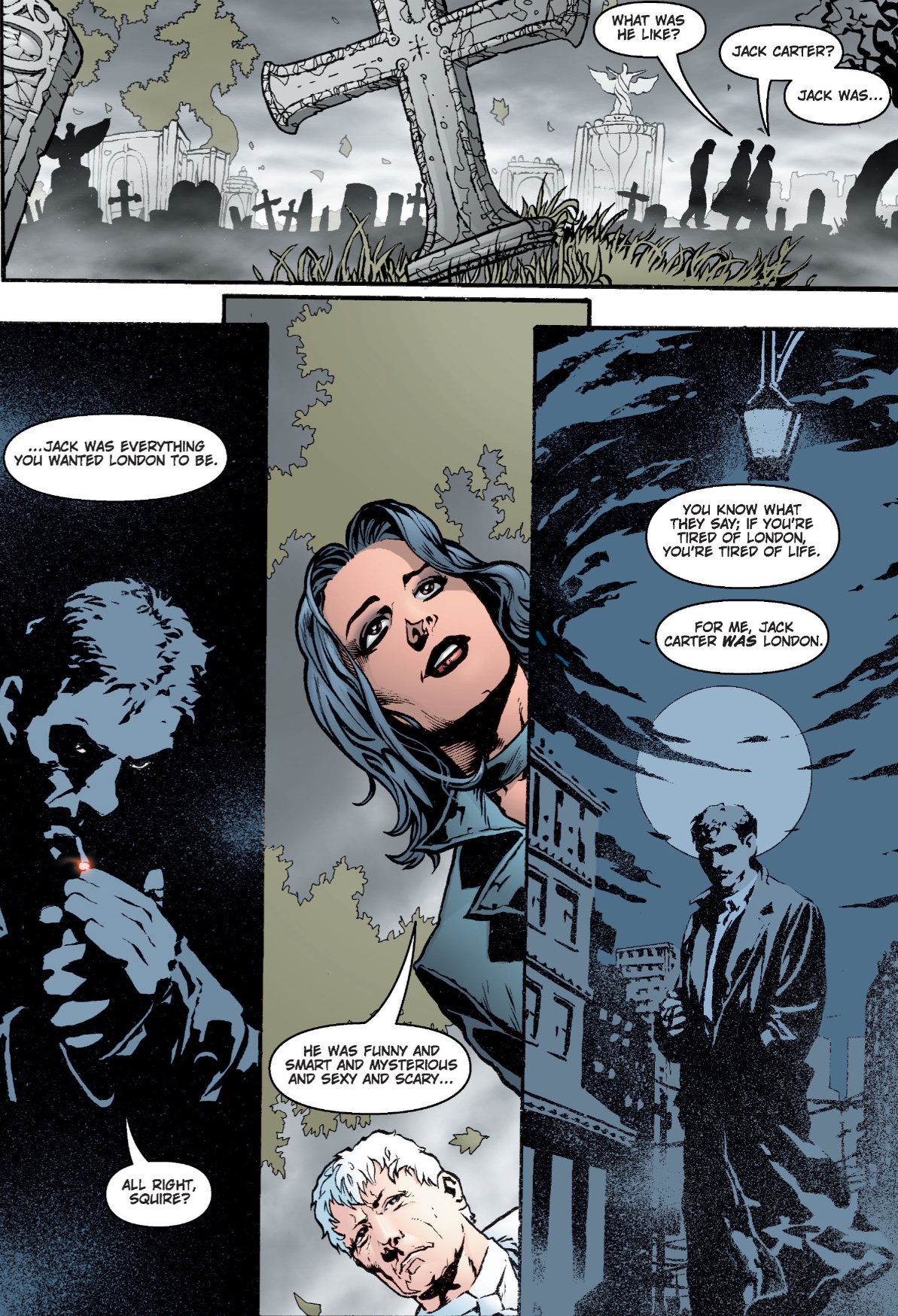 Jack Carter has died, and some Vertigo-y heroes show up to pay their respects. Ellis uses the occasion to make fun of the super-heroic vestiges that clung to the early Vertigo characters as they migrated from the proper DCU in the early 90s.
Jack Carter has died, and some Vertigo-y heroes show up to pay their respects. Ellis uses the occasion to make fun of the super-heroic vestiges that clung to the early Vertigo characters as they migrated from the proper DCU in the early 90s.
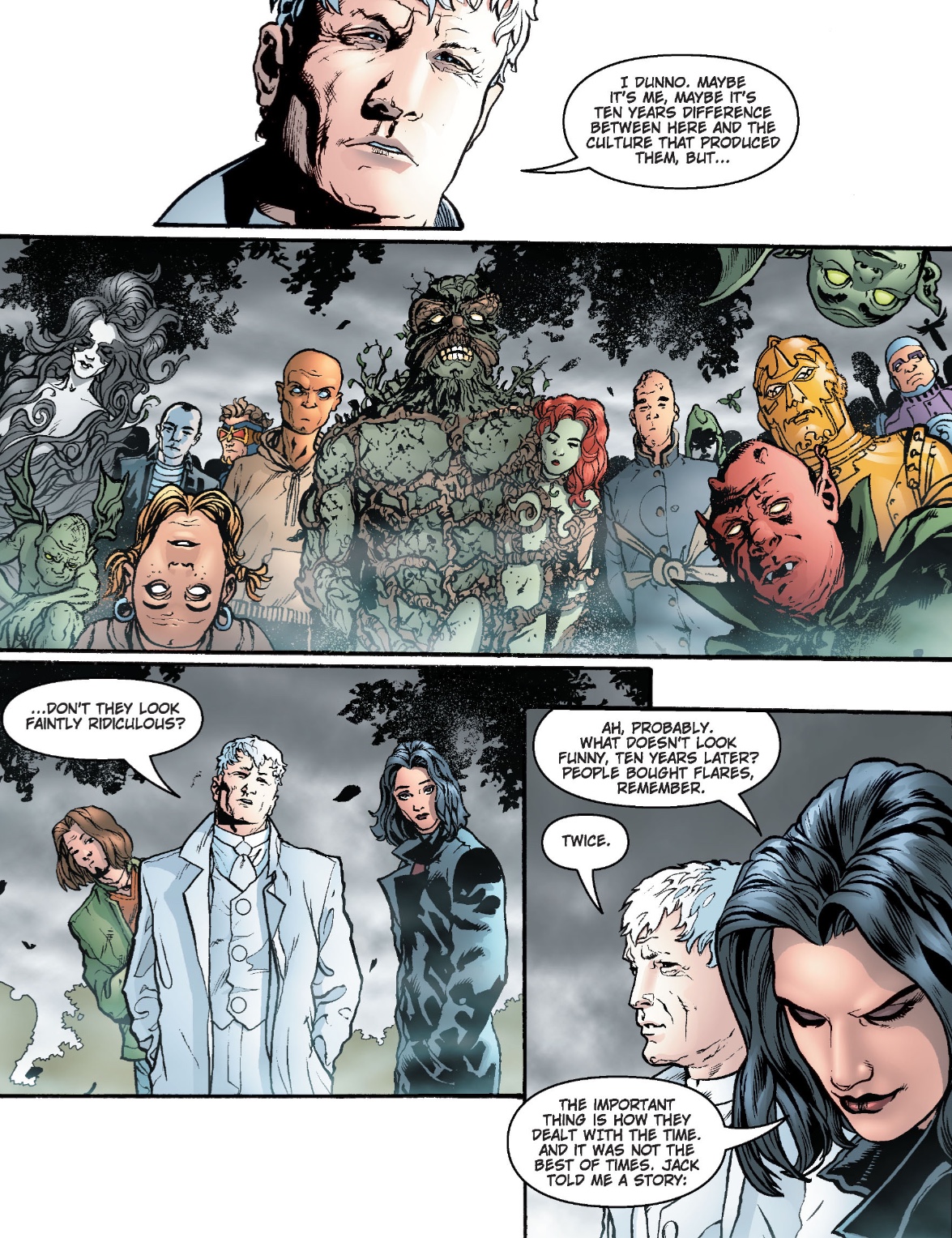 If you look closely, you can see what is clearly meant to be Swamp Thing, the Demon, Robot Man, Animal Man, and (next to him) Grant Morrison.
If you look closely, you can see what is clearly meant to be Swamp Thing, the Demon, Robot Man, Animal Man, and (next to him) Grant Morrison.
We also get a great definition of magic.
 While he’s discussing early 90s comics, Ellis decides to make a statement about revisionist super-heroics. It’s a bit over the top, but I have to admit that this poor fool has a point.
While he’s discussing early 90s comics, Ellis decides to make a statement about revisionist super-heroics. It’s a bit over the top, but I have to admit that this poor fool has a point.
 We learn that Jack had faked his death. Having disposed of the bad/good guy who was trying to kill him, John Constantine reveals his plan to enter the 21st century as Spider Jerusalem.
We learn that Jack had faked his death. Having disposed of the bad/good guy who was trying to kill him, John Constantine reveals his plan to enter the 21st century as Spider Jerusalem.
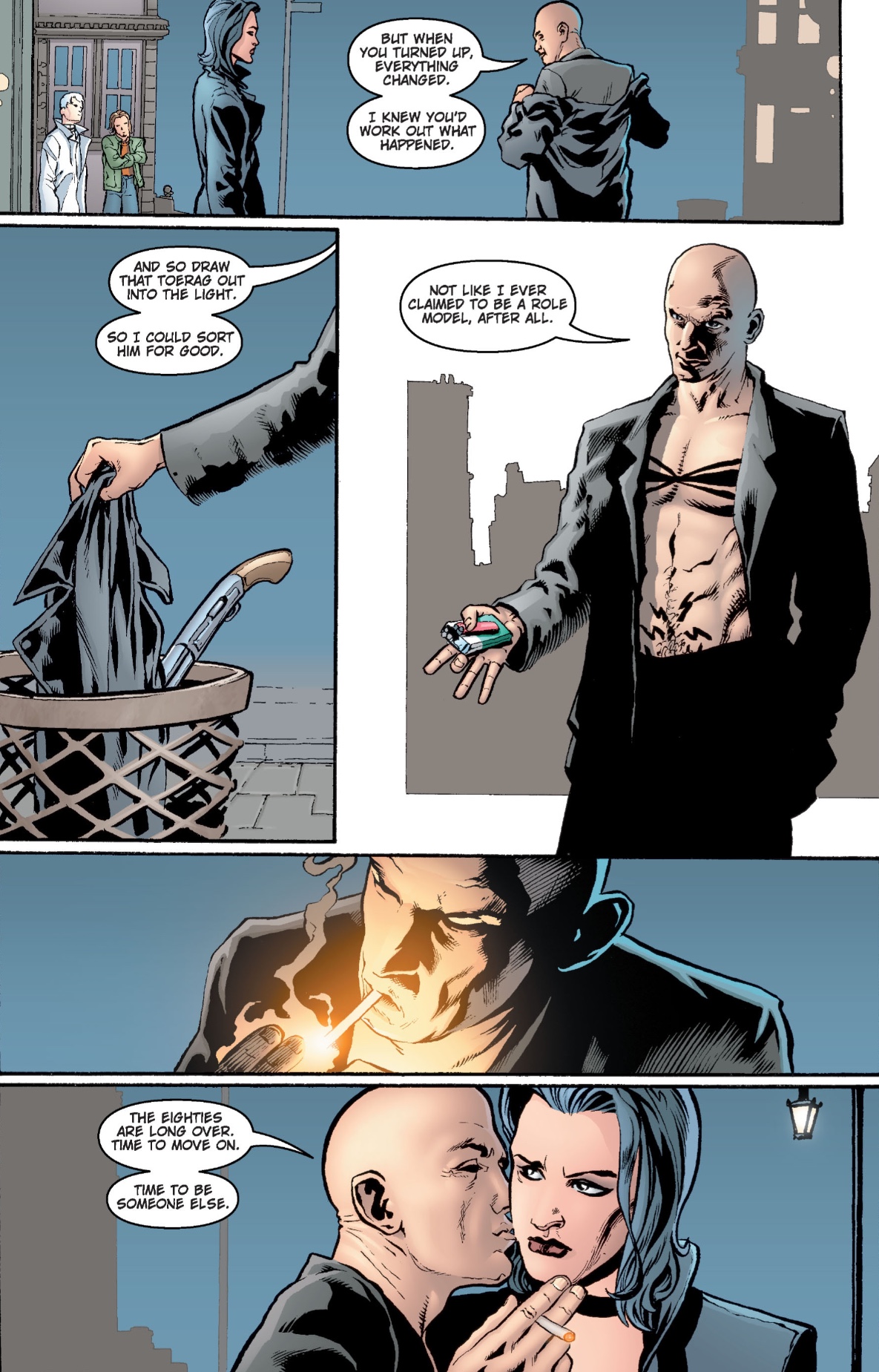
Other Comics I Read from November 1999
- 100 Bullets 6
- Adventures of Superman 574
- Authority 9
- Batman: Dark Victory 2
- Flash 156
- Flash/Green Lantern: The Brave and the Bold 4
- Flinch 8
- Hellblazer 144
- Hitman 45
- Hourman 10
- Invisibles 5
- JLA 37
- JSA 6
- Legends of the Dark Knight 125
- Preacher 57
- Sam and Twitch 4
- Sin City: To Hell and Back 5
- Starman 61
- Superman Adventures 39
- Tomorrow Stories 4
- Top Ten 5
- Transmetropolitan 29
- Winter’s Edge 3
November 2004
JLA Classified 1

This three-issue story arc was Grant Morrison’s return to the JLA, and also served as an unofficial opening chapter to Seven Soldiers, Morrison’s one-man eight series 30 issue cross-over. While it is billed as a JLA story, this first issue focuses entirely on Batman, including a very charming team-up with Squire, who — along with the Knight and the Club of Heroes — will get a lot more attention in Morrison’s Batman run in just a few years.
 I’m always up for Alfred’s dry humor, and who can resist Batman casually talking about his flying saucer and sci-fi closet?
I’m always up for Alfred’s dry humor, and who can resist Batman casually talking about his flying saucer and sci-fi closet?
Cyril is a great window into this story, as — just like us — she’s clearly in over her head but happy to go along for the ride.
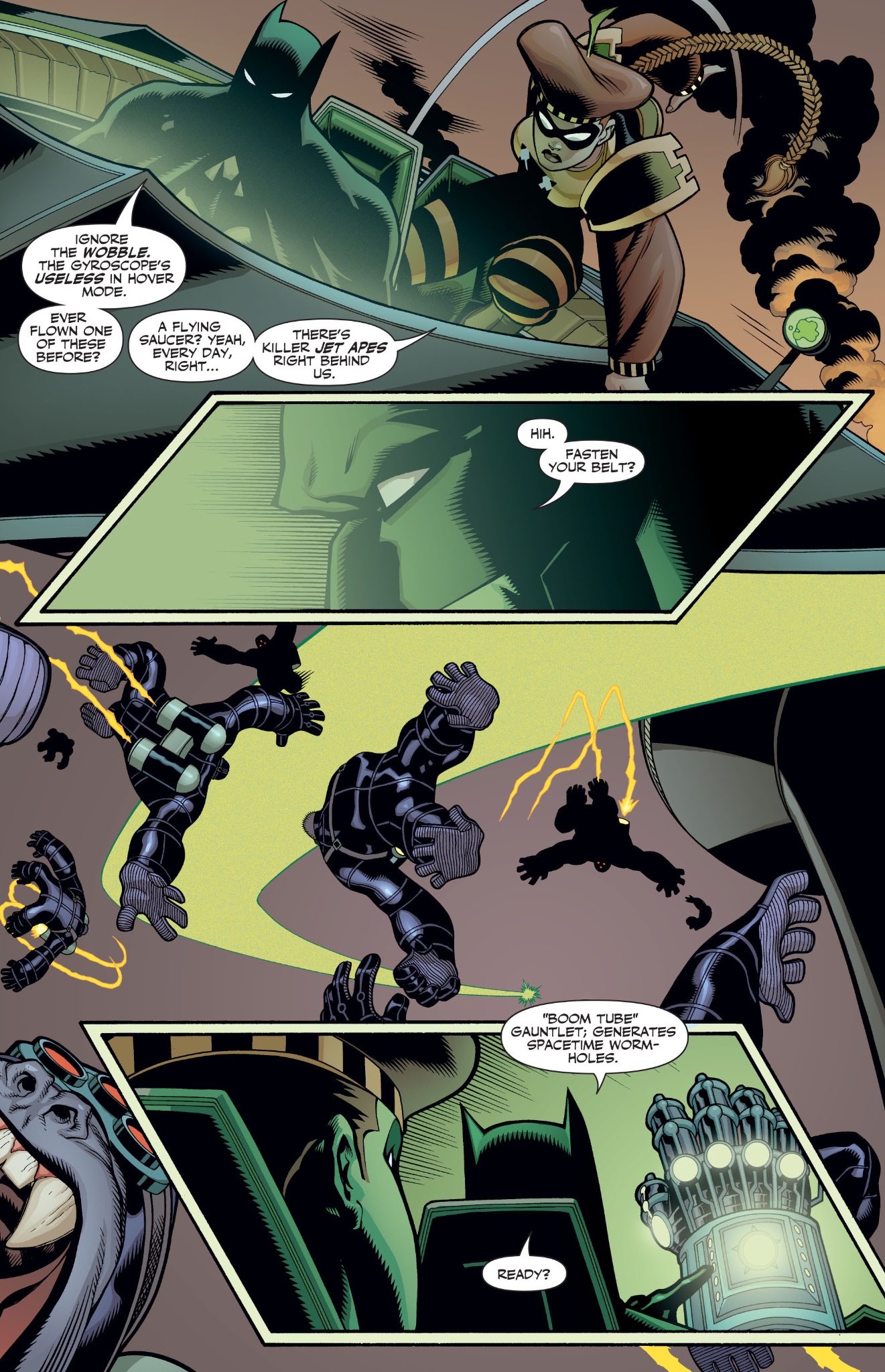 This story gets a lot of ground out of Batman’s ability to communicate Morrison’s insane ideas in such a matter-of-fact tone.
This story gets a lot of ground out of Batman’s ability to communicate Morrison’s insane ideas in such a matter-of-fact tone.
 I could read a thousand pages of Batman and Squire dialogue.
I could read a thousand pages of Batman and Squire dialogue.

Other Comics I Read from November 2004
- 100 Bullets 55
- Adam Strange 3
- Adventures of Superman 634
- Astonishing X-Men 7
- Authority: Revolution 2
- Avengers Finale
- Captain America 1
- Catwoman 37
- Daredevil 67
- Ex Machina 6
- Fantastic Four 520
- Firebirds 1
- Flash 216
- Gotham Central 25
- Green Lantern: Rebirth 2
- Hellblazer 202
- Hulk/Thing: Hark Knocks 3
- Human Target 16
- Identity Crisis 6
- Invincible 17
- Iron Man 1
- JSA 67
- Losers 18
- Lucifer 56
- Madrox 3
- Marvel Team-Up 1, 2
- New Avengers 1
- Ocean 2
- Plastic Man 12
- Powers 6
- Pulse 6
- Punisher 13, 14
- She-Hulk 9
- Sleeper Season Two 6
- Spectacular Spider-Man 21
- Spider-Man Unlimited 6
- Swamp Thing 9
- Teen Titans 18
- Ultimate Fantastic Four 13
- Ultimate Nightmare 4
- Ultimate Spider-Man 68, 69
- Walking Dead 14
- Warlock 3
- Wolverine 22
- Wonder Woman 210
- Y: The Last Man 28
November 2009
Mighty Avengers 30
 If you’re a Henry Pym fan you really need to read Dan Slott’s Mighty Avengers run. In this issue, Pym comes face to face with…
If you’re a Henry Pym fan you really need to read Dan Slott’s Mighty Avengers run. In this issue, Pym comes face to face with…

It doesn’t take long for Pym’s self-doubt to bubble to the surface.
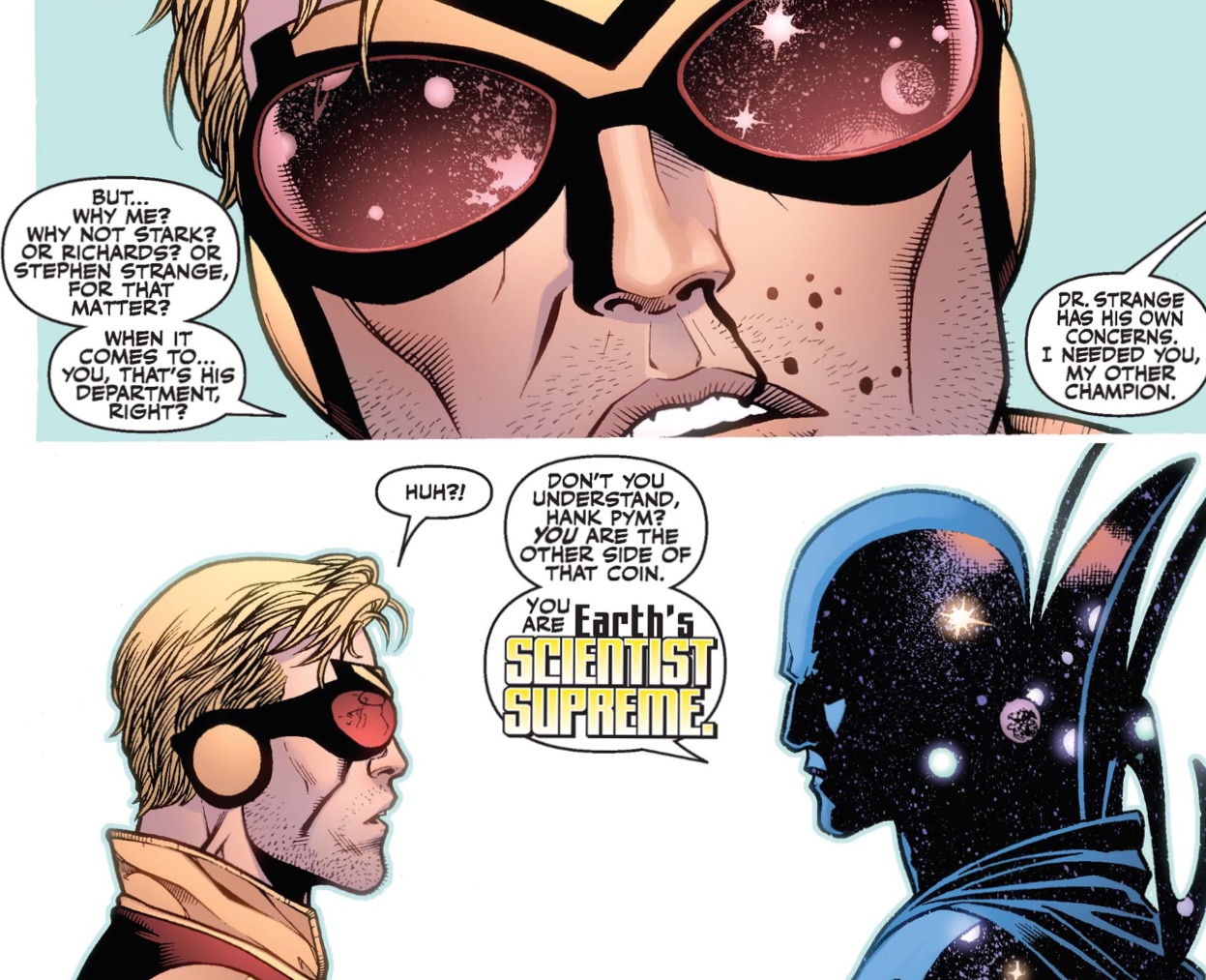 This is such a great idea. I mean, the concept of a Scientist Supreme is great fun in an of itself, but it being Henry Pym is so spot on. And Slott demonstrates a deep understanding of Marvel’s scientific genii. (If only Marvel could convince him write Reed Richard and Tony Stark…)
This is such a great idea. I mean, the concept of a Scientist Supreme is great fun in an of itself, but it being Henry Pym is so spot on. And Slott demonstrates a deep understanding of Marvel’s scientific genii. (If only Marvel could convince him write Reed Richard and Tony Stark…)
 And if that doesn’t make you love Hank Pym, then God, Jed, I don’t even want to know you.
And if that doesn’t make you love Hank Pym, then God, Jed, I don’t even want to know you.
Other Comics I Read from November 2009
- Action Comics 883
- Adventure Comics 4
- Amazing Spider-Man 612, 613
- Assault on New Olympus 1
- Astonishing X-Men 32
- Avengers: Initiative 30
- Batman and Robin 6
- Beasts of Burden 3
- Blackest Night 5
- Captain America: Reborn 4
- Chew 6
- Daredevil 502
- Dark Avengers 11
- Dark Avengers: Ares 2
- Dark Reign: The List: Amazing Spider-Man
- Deadpool Team-Up 899
- Detective Comics 859
- DMZ 47
- Existence 3.0 1
- Fantastic Four 573
- Flash: Rebirth 5
- G-Man: Cape Crisis 4
- Ghost Rider: Heaven’s on Fire 4
- Goon 33
- Greek Street 5
- Green Lantern 48
- Green Lantern Corps 42
- Hellblazer 261
- Incredible Hercules 138
- Incredible Hulk 604
- Invincible 68
- Invincible Iron Man 20
- Iron Man: Requiem
- Lobo: Highway to Hell 1
- Mighty 10
- New Avengers 59
- Northlanders 22
- Outsiders 24
- Phonogram: The Singles Collection 5
- Powers 1
- Punisher Max 1
- Scalped 34
- Seceret Warriors 10
- Spider-Woman 3
- Strange 1
- Strange Tales 3
- Superman: Secret Origin 3
- Sweet Tooth 3
- SWORD 1
- Thor Giant-Size Finale
- Ultimate Armor Wars 3
- Ultimate Comics Avengers 4
- Ultimate Comics Spider-Man 4
- Uncanny X-Men 517
- Unknown Soldier 14
- Walking Dead 67
- War Machine 11
- Wolverine: Weapon X 7
November 2014
Multiversity: Pax Americana
 If Happy is Grant Morrison telling Mark Millar that anyone can crap out an ultra-violent comic and sell it to Hollywood, then Pax Americana is Grant Morrison telling Alan Moore that while not everyone can mimic Moore’s intricate Watchmen storytelling techniques, he certainly can.
If Happy is Grant Morrison telling Mark Millar that anyone can crap out an ultra-violent comic and sell it to Hollywood, then Pax Americana is Grant Morrison telling Alan Moore that while not everyone can mimic Moore’s intricate Watchmen storytelling techniques, he certainly can.
There’s no way I can even begin to unpack everything in this comic in the time we have. One could literally write an entire book on this comic. Here’s what you need to know:
- This comic takes place on Earth-4, where the Charlton heroes live. These characters were the inspiration for the Watchmen characters.
- Generally speaking, the story is told backwards, but we are also jumping all around time. This illustrates how Captain Adam (Dr. Manhattan) experiences time, and allows for some genuine bravura storytelling from Frank Quitely, especially on a 32-panel double-page spread that takes place in three separate timelines.
- Pax Americana uses an 8-panel grid. This references Watchmen‘s 9-panel grid, but has a lot more behind it.
- Morrison has stated that Multiversity is based on the number 8, more specifically the Western 8-note musical octave.
- Eights appear as frequently on the pages of Pax Americana as smiley faces do on the pages of Watchmen.
- The eights symbolize the number 8, but also infinity, as well as the traditional super-hero domino mask.
The comic opens with the assassination of President Harley (Ozymandias) by the Peacemaker (The Comedian). This scene plays out backwards to prepare us for the fact that this event takes place chronologically at the end of our story.  Of course, Watchmen opens with the opposite murder — Ozymandias killing the Comedian. Note President Harley’s ring, and the blood running over the S to form another 8.
Of course, Watchmen opens with the opposite murder — Ozymandias killing the Comedian. Note President Harley’s ring, and the blood running over the S to form another 8.
“Later,” Governor Harley discusses his own murder with Captain Adam.
 To better understand why Harley sees himself as “the ultimate villain” and what his ring really symbolizes, let’s look at the last page of the comic to see the true beginning of the story, when Harley first sees the pattern:
To better understand why Harley sees himself as “the ultimate villain” and what his ring really symbolizes, let’s look at the last page of the comic to see the true beginning of the story, when Harley first sees the pattern:
 The Question (Rorschach) and Blue Beetle (Night Owl) spend much of this comic discussing the mystery surrounding the disappearance of Yellowjacket, one of their original super-heroes. Yellowjacket was President Harley’s father, and the comic ends with the revelation that as a child, Harley accidentally killed Yellowjacket.
The Question (Rorschach) and Blue Beetle (Night Owl) spend much of this comic discussing the mystery surrounding the disappearance of Yellowjacket, one of their original super-heroes. Yellowjacket was President Harley’s father, and the comic ends with the revelation that as a child, Harley accidentally killed Yellowjacket.
There are eights hidden on pretty much every page. My personal favorite is the blood splatter pattern left after a bird is shot out of the sky.
 And speaking of patterns:
And speaking of patterns:
 The “randomly” spilled coffee forms another eight. But is it truly random? I mean, Morrison asked Quitely to draw it that way, right?
The “randomly” spilled coffee forms another eight. But is it truly random? I mean, Morrison asked Quitely to draw it that way, right?
 There are eights on the Question’s card and in the negative space of Nightshade’s (Silk Spectre) mask, of course, but also “who controls the board?” Surely it’s Grant Morrison.
There are eights on the Question’s card and in the negative space of Nightshade’s (Silk Spectre) mask, of course, but also “who controls the board?” Surely it’s Grant Morrison.
Here we have Captain Adam offering as clear a statement of Morrison’s Grand Unified Theory of Comics as you’re ever going to get.
 Another frequently appearing symbol is the peace sign. Note how the gutter between the second and third panel makes the two clocks into a peace sign, reminding us that we’re reading a comic while simultaneously referencing Watchmen‘s Doomsday Clock. Other recurring symbols include Janus and a dot/hole/circle — you can see it in several of the panels above, including the bullet hole in Yellowjacket’s domino mask.
Another frequently appearing symbol is the peace sign. Note how the gutter between the second and third panel makes the two clocks into a peace sign, reminding us that we’re reading a comic while simultaneously referencing Watchmen‘s Doomsday Clock. Other recurring symbols include Janus and a dot/hole/circle — you can see it in several of the panels above, including the bullet hole in Yellowjacket’s domino mask.
“Later” Captain Adam takes his beloved dog apart (referencing Dr. Manhattan’s sacrifice of Bubastis):
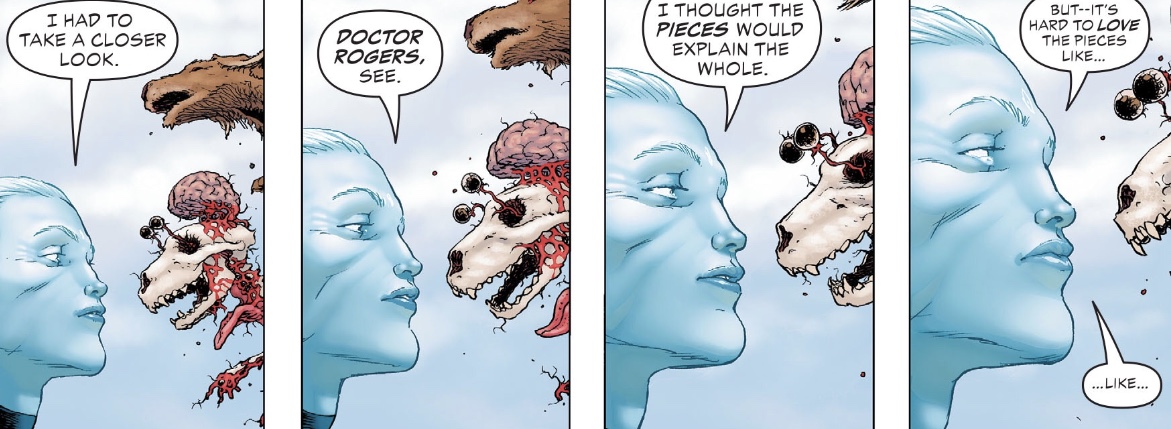 His “closer look” leads to heart-break, as it’s quite literally “hard to love to pieces.” This has always been Morrison’s problem with Watchmen, and revisionist comics in general: super-heroes are not meant to be taken apart like this. When you break them down to their component parts, you destroy them.
His “closer look” leads to heart-break, as it’s quite literally “hard to love to pieces.” This has always been Morrison’s problem with Watchmen, and revisionist comics in general: super-heroes are not meant to be taken apart like this. When you break them down to their component parts, you destroy them.
Morrison then points out the low stakes, cyclical nature of super-hero comics by having Captain Atom immediately bring his dog back to life.
 And by existing simultaneously as both dead and alive, Butch represents the DC Multiverse’s messy continuity.
And by existing simultaneously as both dead and alive, Butch represents the DC Multiverse’s messy continuity.
Now let’s take a moment to appreciate Frank Quitely’s work on this brilliantly designed page:
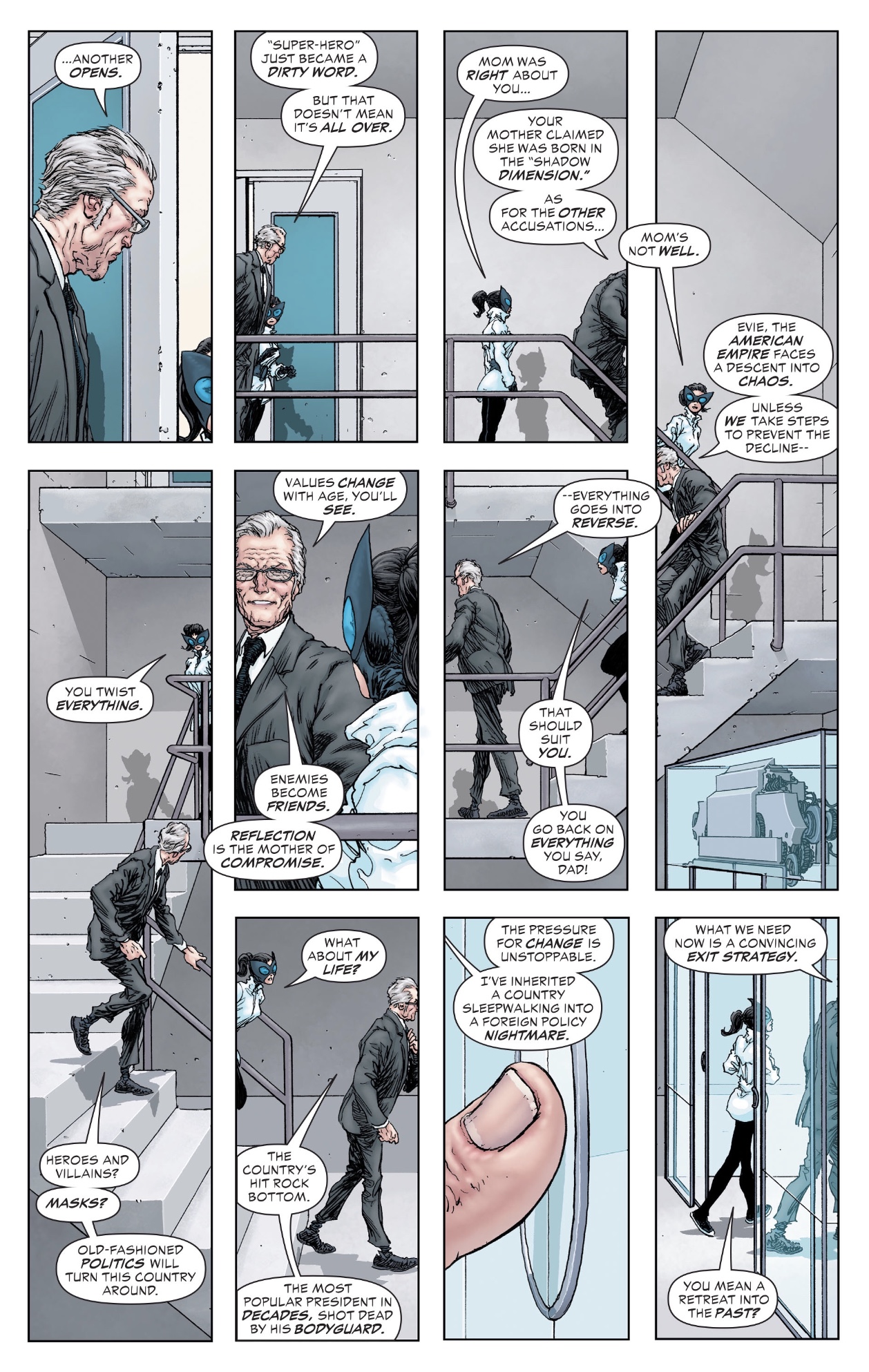 You are asked to read the page in a wildly non-intuitive manner, but the impeccable design makes it impossible to read incorrectly. And Morrison out-Moores Moore with dialogue that references the page layout — “we take steps” as they enter the stairwell, “goes into reverse” as they round the corner and we start to read the panels right to left, “twist” as they round another corner, “turn this.. around” as they begin to go left to right again, “hit rock bottom” as they reach the end of the stairwell, “pressure” as he pushes the button, then we end the page with an “exit strategy” and going “into the past,” which leads you back to the first panel mentioning another door opening. And as you follow the characters down the stairs, then back up to the first panel, your eye-line forms another 8.
You are asked to read the page in a wildly non-intuitive manner, but the impeccable design makes it impossible to read incorrectly. And Morrison out-Moores Moore with dialogue that references the page layout — “we take steps” as they enter the stairwell, “goes into reverse” as they round the corner and we start to read the panels right to left, “twist” as they round another corner, “turn this.. around” as they begin to go left to right again, “hit rock bottom” as they reach the end of the stairwell, “pressure” as he pushes the button, then we end the page with an “exit strategy” and going “into the past,” which leads you back to the first panel mentioning another door opening. And as you follow the characters down the stairs, then back up to the first panel, your eye-line forms another 8.
Below the Question discusses many plot points from Watchmen, and Blue Beetle points out that the Question doesn’t seem to be as rigid in his belief system as he used to be.

This references Denny O’Neil taking the Question kicking and screaming from his Randian roots into Zen Buddhism, and also reveals another way that eight ties into the story. As created, the Question (and certainly Rorschach) had a binary sense of right and wrong. But this Question has a much more nuanced (if no less insane) world view. Steve Ditko created the Question to reflect the Objectivist philosophy of Ayn Rand. Morrison reimagines him as a believer in Ken Wilbur’s Integral theory of Spiral Dynamics. Rather than Rand’s figuratively black and white world view, Wilbur’s is quite literally based on colors. (Eight guesses how many colors he uses?)
Here the Question breaks it all down for us. I love how Morrison gives us the clues to what’s going on while simultaneously letting us know that his Question is just as overbearing and insane as Rorschach by placing him in front of his overly wordy speech.
 I feel like I’ve overstayed my welcome on this one, but let me end by pointing out that the panels above are also a clue to the larger story, as the history of the world of Pax Americana maps to these eight societal standards. And once you know that, you can track where you are in the story’s timeline, as the pages are colored to reflect what Spiral Dynamic stage you’re in.
I feel like I’ve overstayed my welcome on this one, but let me end by pointing out that the panels above are also a clue to the larger story, as the history of the world of Pax Americana maps to these eight societal standards. And once you know that, you can track where you are in the story’s timeline, as the pages are colored to reflect what Spiral Dynamic stage you’re in.
Other Comics I Read from November 2014
- Action Comics 36
- All-New X-Factor 16
- Astro City 17
- Avengers 38
- Batman 36
- Batman and Robin 36
- Batman/Superman 16
- Black Widow 12
- Bucky Barnes: The Winter Soldier 2
- Captain Marvel 9
- Chew 44
- Copperhead 3
- Cyclops 7
- Daredevil 10
- Deadly Class 9
- Deathlok 2
- Dream Police 5
- The Fade Out 3
- Grayson 4
- Invincible 115
- Justice League 36
- Lazarus 13
- Manhattan Projects 25
- Men of Wrath 2
- MPH 4
- Names 3
- New Avengers 26, 27
- ODY-C 1
- Outcast 5
- Powers: Bureau 12
- Protectors, Inc. 10
- Punisher 12
- Punk Mambo 0
- Revival 25
- Savage Hulk 6
- Secret Avengers 10
- She-Hulk 10
- Sheltered 13
- Sidekick 9
- Spread 4
- Storm 5
- Superior Foes of Spider-Man 17
- Superman 36
- Superman/Wonder Woman 13
- Thief of Thieves 25
- Thor 2
- Trees 7
- Velvet 8
- Walking Dead 134
- Wayward 4
- Wytches 2
- Zero 12
Dear Spoilerite,
At Major Spoilers, we strive to create original content that you find interesting and entertaining. Producing, writing, recording, editing, and researching requires significant resources. We pay writers, podcast hosts, and other staff members who work tirelessly to provide you with insights into the comic book, gaming, and pop culture industries. Help us keep MajorSpoilers.com strong. Become a Patron (and our superhero) today.



2 Comments
Great stuff, like always!
Much appreciated!